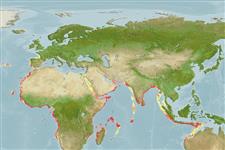Holocephali (chimaeras) >
Chimaeriformes (Chimaeras) >
Rhinochimaeridae (Longnose chimaeras)
Etymology: Neoharriotta: neo-, from neos (Gr.), new, i.e., a new genus related to Harriotta. (See ETYFish); pinnata: Latin for winged, possibly referring to its broad pectoral fins. (See ETYFish).
Environment: milieu / climate zone / depth range / distribution range
Ecology
Marine; bathydemersal; depth range 150 - 800 m (Ref. 4444), usually 200 - 470 m (Ref. 36731). Deep-water; - 23°S
Eastern Atlantic: Cape Blanc, Mauritania to Walvis Bay, Namibia (Ref. 4444). Indian Ocean: Arabian Sea (Ref. 45795) and India (Ref. 118627).
Size / Weight / Age
Maturity: Lm ? range ? - ? cm
Max length : 130 cm TL male/unsexed; (Ref. 36731)
Short description
Morphology | Morphometrics
A longnose chimaera with a narrow, slightly flattened snout, and blunt-edged, ridged tooth plates; pectoral fins short and broad, anal fin large and curved, and caudal fin with no tubercles on upper edge but with a short terminal filament (Ref. 5578). Dark brown in color (Ref. 5578).
Oviparous (Ref. 205). Lays spindle-shaped eggs (Ref. 5578). Maximum depth reported taken from Ref. 9773.
Life cycle and mating behavior
Maturity | Reproduction | Spawning | Eggs | Fecundity | Larvae
Krefft, G., 1990. Rhinochimaeridae. p. 114-116. In J.C. Quero, J.C. Hureau, C. Karrer, A. Post and L. Saldanha (eds.) Check-list of the fishes of the eastern tropical Atlantic (CLOFETA). JNICT, Lisbon; SEI, Paris; and UNESCO, Paris. Vol. 1. (Ref. 4444)
IUCN Red List Status (Ref. 130435)
Threat to humans
Harmless
Human uses
More information
Age/SizeGrowthLength-weightLength-lengthLength-frequenciesMorphometricsMorphologyLarvaeLarval dynamicsRecruitmentAbundanceBRUVS
ReferencesAquacultureAquaculture profileStrainsGeneticsElectrophoresesHeritabilityDiseasesProcessingNutrientsMass conversion
Tools
Special reports
Download XML
Internet sources
Estimates based on models
Preferred temperature (Ref.
123201): 7.4 - 15.6, mean 12.3 °C (based on 83 cells).
Phylogenetic diversity index (Ref.
82804): PD
50 = 0.6289 [Uniqueness, from 0.5 = low to 2.0 = high].
Bayesian length-weight: a=0.00135 (0.00062 - 0.00294), b=3.11 (2.92 - 3.30), in cm total length, based on LWR estimates for this species & (Sub)family-body (Ref.
93245).
Trophic level (Ref.
69278): 4.3 ±0.64 se; based on food items.
Resilience (Ref.
120179): Low, minimum population doubling time 4.5 - 14 years (Assuming Fec <100).
Fishing Vulnerability (Ref.
59153): Very high vulnerability (78 of 100).
